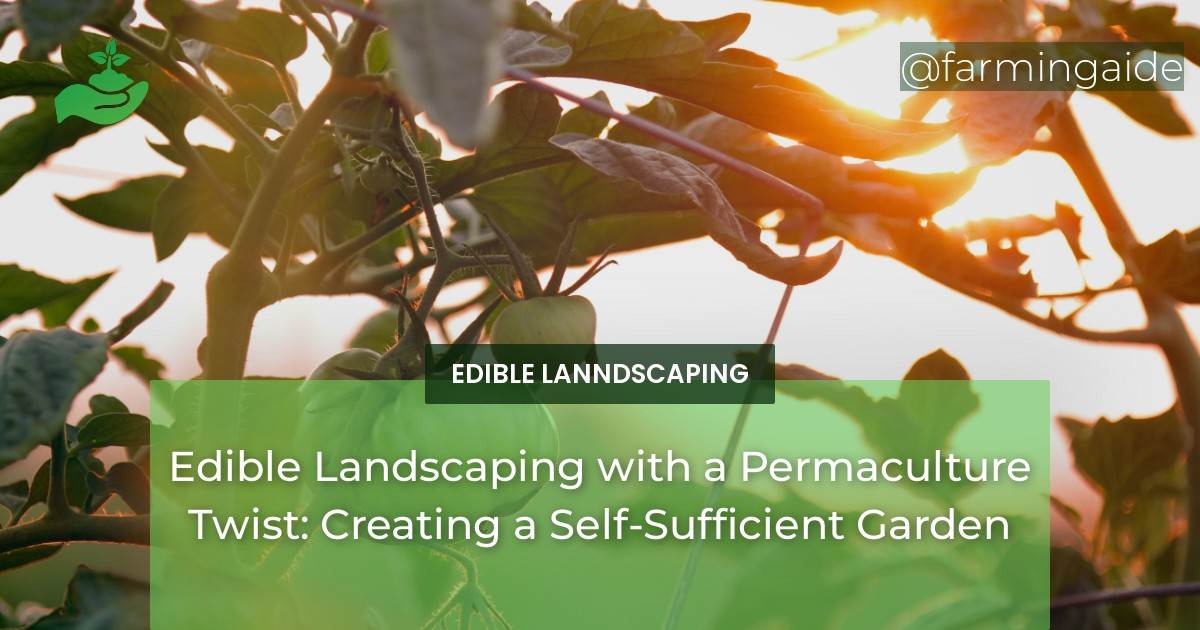Welcome to the world of edible landscaping with a permaculture twist! This innovative approach to gardening combines the principles of permaculture with the beauty and functionality of edible plants. By incorporating edible plants into your landscape, you can create a self-sufficient garden that not only provides food for you and your family, but also supports the local ecosystem and promotes sustainable gardening practices. In this comprehensive article, we will explore the concept of edible landscaping with a permaculture twist and provide you with all the necessary information to get started on your own edible landscape. From plant selection and cultivation to soil management and pest control, we will cover it all. So let’s dig in and discover the world of edible landscaping with a permaculture twist!
What is Edible Landscaping?
Edible landscaping is the practice of incorporating edible plants into your landscape design. This can include fruits, vegetables, herbs, and even edible flowers. The goal of edible landscaping is to create a beautiful and functional landscape that not only provides food, but also enhances the overall aesthetic of your outdoor space. Unlike traditional vegetable gardens, which are often tucked away in a corner of the yard, edible landscaping integrates edible plants throughout the entire landscape, making them a seamless part of the design.
The Permaculture Twist
Permaculture is a design system that focuses on creating sustainable and self-sufficient ecosystems. It is based on the principles of working with nature rather than against it, and promoting diversity and resilience in the garden. When applied to edible landscaping, permaculture principles can help create a more productive and sustainable garden. By mimicking natural ecosystems, edible landscapes with a permaculture twist can be low maintenance, conserve resources, and support local wildlife.
Plant Selection and Cultivation
The first step in creating an edible landscape with a permaculture twist is selecting the right plants. When choosing plants, consider their function in the landscape, as well as their edible qualities. Some plants may provide food, while others may serve as a natural pest deterrent or provide habitat for beneficial insects. It is important to choose plants that are well-suited to your climate and growing conditions, and that complement each other in terms of growth habits and nutrient needs.
When it comes to cultivation, permaculture principles emphasize the importance of working with nature rather than against it. This means using organic and sustainable gardening practices, such as composting, crop rotation, and companion planting. These practices not only promote healthy plant growth, but also help maintain a balanced ecosystem in the garden.
Soil Management and Composting
Healthy soil is the foundation of any successful garden, and this is especially true for edible landscapes with a permaculture twist. Permaculture principles emphasize the importance of building and maintaining healthy soil through techniques such as no-till gardening, mulching, and cover cropping. These practices help improve soil structure, increase nutrient availability, and promote beneficial microorganisms.
Composting is also an essential part of permaculture gardening. By composting kitchen scraps and yard waste, you can create a nutrient-rich soil amendment that will help feed your plants and improve overall soil health. Composting also reduces waste and conserves resources, making it a sustainable practice for your edible landscape.
Pest and Disease Control
One of the biggest challenges in any garden is dealing with pests and diseases. In permaculture gardening, the focus is on prevention rather than treatment. By creating a diverse and balanced ecosystem, you can reduce the likelihood of pest and disease outbreaks. This can be achieved through techniques such as crop rotation, companion planting, and using natural pest deterrents like beneficial insects and companion plants.
In the event of a pest or disease problem, permaculture principles encourage natural and organic methods of control, such as handpicking pests, using homemade sprays, and introducing natural predators. These methods are not only better for the environment, but also help maintain a healthy balance in the garden.
Sustainable Gardening Practices
Permaculture principles promote sustainable gardening practices that not only benefit the garden, but also the environment as a whole. By using techniques such as rainwater harvesting, composting, and natural pest control, you can reduce your environmental impact and create a more self-sufficient garden. Additionally, permaculture principles emphasize the importance of conserving resources and reducing waste, making it a more sustainable approach to gardening.
Seasonal Planning and Crop Rotation
Seasonal planning and crop rotation are key components of permaculture gardening. By planning your garden according to the seasons, you can ensure a continuous supply of fresh produce throughout the year. Crop rotation is also important for maintaining soil health and preventing pest and disease problems. By rotating crops, you can avoid depleting the soil of specific nutrients and reduce the buildup of pests and diseases.
Can a Self-Sufficient Garden be Created with Edible Landscaping Plans for Every Garden Size and Shape?
Yes, a self-sufficient garden can be created with the right edible landscaping plans for any garden size and shape. Through strategic placement of edible plants, such as fruit trees, herbs, and vegetables, a garden can not only be aesthetically pleasing but also provide a sustainable source of fresh produce.
Conclusion
Edible landscaping with a permaculture twist is a unique and innovative approach to gardening that combines beauty and functionality. By incorporating edible plants into your landscape, you can create a self-sufficient garden that supports the local ecosystem and promotes sustainable gardening practices. From plant selection and cultivation to soil management and pest control, permaculture principles can help you create a productive and sustainable edible landscape. So why not give it a try and see the benefits for yourself?
RELATED ARTICLES:


